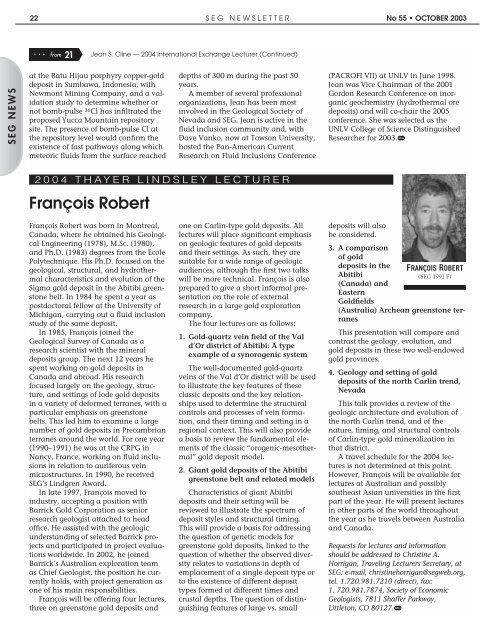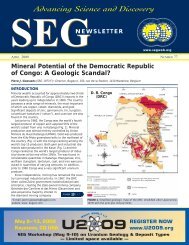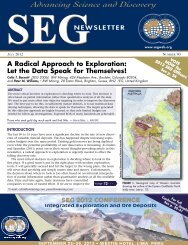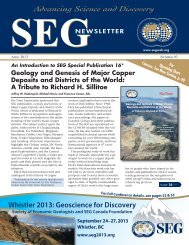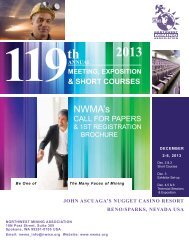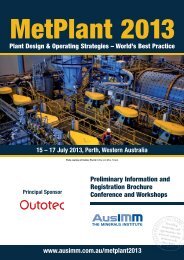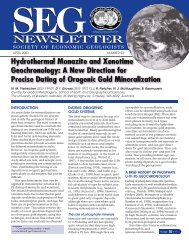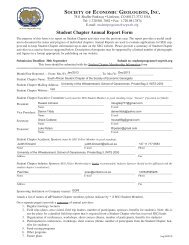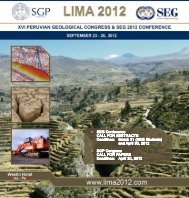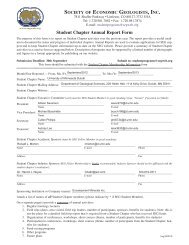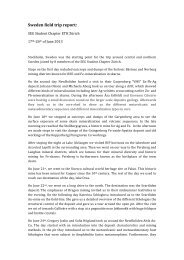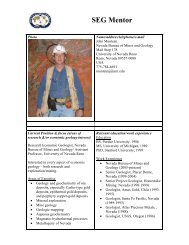SEG 45 Final_qx4 - Society of Economic Geologists
SEG 45 Final_qx4 - Society of Economic Geologists
SEG 45 Final_qx4 - Society of Economic Geologists
Create successful ePaper yourself
Turn your PDF publications into a flip-book with our unique Google optimized e-Paper software.
22 <strong>SEG</strong> NEWSLETTER No 55 • OCTOBER 2003<br />
... from 21<br />
Jean S. Cline — 2004 International Exchange Lecturer (Continued)<br />
<strong>SEG</strong> NEWS<br />
at the Batu Hijau porphyry copper-gold<br />
deposit in Sumbawa, Indonesia, with<br />
Newmont Mining Company, and a validation<br />
study to determine whether or<br />
not bomb-pulse 36 Cl has infiltrated the<br />
proposed Yucca Mountain repository<br />
site. The presence <strong>of</strong> bomb-pulse Cl at<br />
the repository level would confirm the<br />
existence <strong>of</strong> fast pathways along which<br />
meteoric fluids from the surface reached<br />
depths <strong>of</strong> 300 m during the past 50<br />
years.<br />
A member <strong>of</strong> several pr<strong>of</strong>essional<br />
organizations, Jean has been most<br />
involved in the Geological <strong>Society</strong> <strong>of</strong><br />
Nevada and <strong>SEG</strong>. Jean is active in the<br />
fluid inclusion community and, with<br />
Dave Vanko, now at Towson University,<br />
hosted the Pan-American Current<br />
Research on Fluid Inclusions Conference<br />
(PACROFI VII) at UNLV in June 1998.<br />
Jean was Vice Chairman <strong>of</strong> the 2001<br />
Gordon Research Conference on inorganic<br />
geochemistry (hydrothermal ore<br />
deposits) and will co-chair the 2005<br />
conference. She was selected as the<br />
UNLV College <strong>of</strong> Science Distinguished<br />
Researcher for 2003.1<br />
2004 THAYER LINDSLEY LECTURER<br />
François Robert<br />
François Robert was born in Montreal,<br />
Canada, where he obtained his Geological<br />
Engineering (1978), M.Sc. (1980),<br />
and Ph.D. (1983) degrees from the Ecole<br />
Polytechnique. His Ph.D. focused on the<br />
geological, structural, and hydrothermal<br />
characteristics and evolution <strong>of</strong> the<br />
Sigma gold deposit in the Abitibi greenstone<br />
belt. In 1984 he spent a year as<br />
postdoctoral fellow at the University <strong>of</strong><br />
Michigan, carrying out a fluid inclusion<br />
study <strong>of</strong> the same deposit.<br />
In 1985, François joined the<br />
Geological Survey <strong>of</strong> Canada as a<br />
research scientist with the mineral<br />
deposits group. The next 12 years he<br />
spent working on gold deposits in<br />
Canada and abroad. His research<br />
focused largely on the geology, structure,<br />
and settings <strong>of</strong> lode gold deposits<br />
in a variety <strong>of</strong> deformed terranes, with a<br />
particular emphasis on greenstone<br />
belts. This led him to examine a large<br />
number <strong>of</strong> gold deposits in Precambrian<br />
terranes around the world. For one year<br />
(1990–1991) he was at the CRPG in<br />
Nancy, France, working on fluid inclusions<br />
in relation to auriferous vein<br />
microstructures. In 1990, he received<br />
<strong>SEG</strong>’s Lindgren Award.<br />
In late 1997, François moved to<br />
industry, accepting a position with<br />
Barrick Gold Corporation as senior<br />
research geologist attached to head<br />
<strong>of</strong>fice. He assisted with the geologic<br />
understanding <strong>of</strong> selected Barrick projects<br />
and participated in project evaluations<br />
worldwide. In 2002, he joined<br />
Barrick’s Australian exploration team<br />
as Chief Geologist, the position he currently<br />
holds, with project generation as<br />
one <strong>of</strong> his main responsibilities.<br />
François will be <strong>of</strong>fering four lectures,<br />
three on greenstone gold deposits and<br />
one on Carlin-type gold deposits. All<br />
lectures will place significant emphasis<br />
on geologic features <strong>of</strong> gold deposits<br />
and their settings. As such, they are<br />
suitable for a wide range <strong>of</strong> geologic<br />
audiences, although the first two talks<br />
will be more technical. François is also<br />
prepared to give a short informal presentation<br />
on the role <strong>of</strong> external<br />
research in a large gold exploration<br />
company.<br />
The four lectures are as follows:<br />
1. Gold-quartz vein field <strong>of</strong> the Val<br />
d’Or district <strong>of</strong> Abitibi: A type<br />
example <strong>of</strong> a synorogenic system<br />
The well-documented gold-quartz<br />
veins <strong>of</strong> the Val d’Or district will be used<br />
to illustrate the key features <strong>of</strong> these<br />
classic deposits and the key relationships<br />
used to determine the structural<br />
controls and processes <strong>of</strong> vein formation,<br />
and their timing and setting in a<br />
regional context. This will also provide<br />
a basis to review the fundamental elements<br />
<strong>of</strong> the classic “orogenic-mesothermal”<br />
gold deposit model.<br />
2. Giant gold deposits <strong>of</strong> the Abitibi<br />
greenstone belt and related models<br />
Characteristics <strong>of</strong> giant Abitibi<br />
deposits and their setting will be<br />
reviewed to illustrate the spectrum <strong>of</strong><br />
deposit styles and structural timing.<br />
This will provide a basis for addressing<br />
the question <strong>of</strong> genetic models for<br />
greenstone gold deposits, linked to the<br />
question <strong>of</strong> whether the observed diversity<br />
relates to variations in depth <strong>of</strong><br />
emplacement <strong>of</strong> a single deposit type or<br />
to the existence <strong>of</strong> different deposit<br />
types formed at different times and<br />
crustal depths. The question <strong>of</strong> distinguishing<br />
features <strong>of</strong> large vs. small<br />
deposits will also<br />
be considered.<br />
3. A comparison<br />
<strong>of</strong> gold<br />
deposits in the<br />
Abitibi<br />
(Canada) and<br />
Eastern<br />
Goldfields<br />
FRANÇOIS ROBERT<br />
(<strong>SEG</strong> 1991 F)<br />
(Australia) Archean greenstone terranes<br />
This presentation will compare and<br />
contrast the geology, evolution, and<br />
gold deposits in these two well-endowed<br />
gold provinces.<br />
4. Geology and setting <strong>of</strong> gold<br />
deposits <strong>of</strong> the north Carlin trend,<br />
Nevada<br />
This talk provides a review <strong>of</strong> the<br />
geologic architecture and evolution <strong>of</strong><br />
the north Carlin trend, and <strong>of</strong> the<br />
nature, timing, and structural controls<br />
<strong>of</strong> Carlin-type gold mineralization in<br />
that district.<br />
A travel schedule for the 2004 lectures<br />
is not determined at this point.<br />
However, François will be available for<br />
lectures at Australian and possibly<br />
southeast Asian universities in the first<br />
part <strong>of</strong> the year. He will present lectures<br />
in other parts <strong>of</strong> the world throughout<br />
the year as he travels between Australia<br />
and Canada.<br />
Requests for lectures and information<br />
should be addressed to Christine A.<br />
Horrigan, Traveling Lecturers Secretary, at<br />
<strong>SEG</strong>: e-mail, christinehorrigan@segweb.org,<br />
tel. 1.720.981.7210 (direct), fax:<br />
1. 720.981.7874, <strong>Society</strong> <strong>of</strong> <strong>Economic</strong><br />
<strong>Geologists</strong>, 7811 Shaffer Parkway,<br />
Littleton, CO 80127.1


